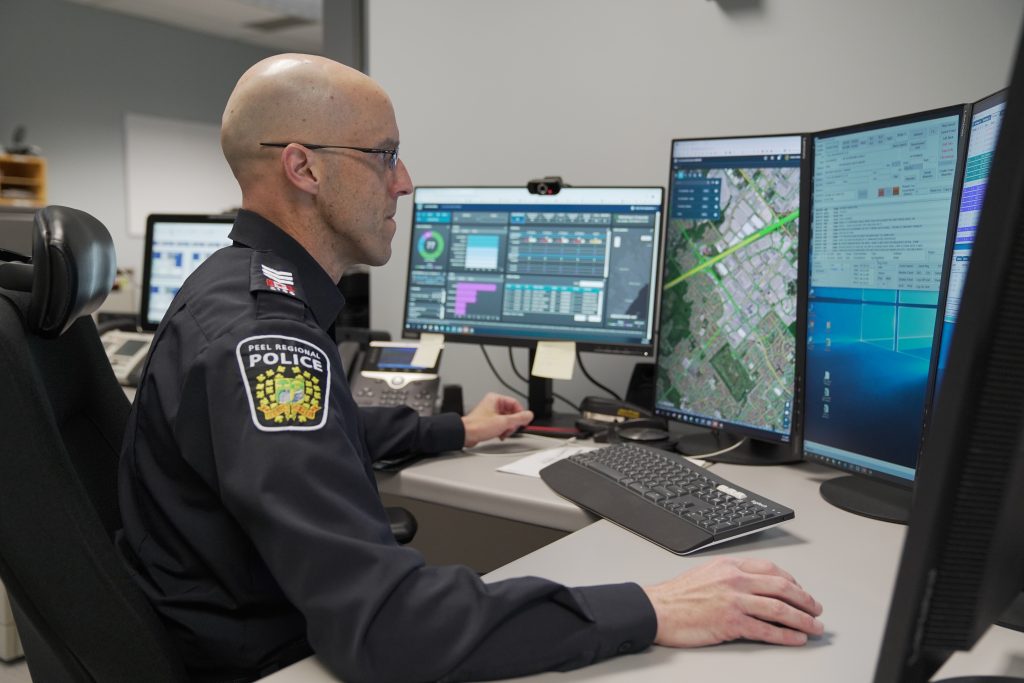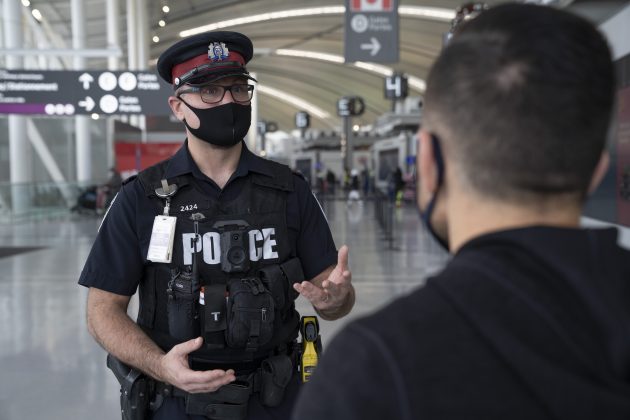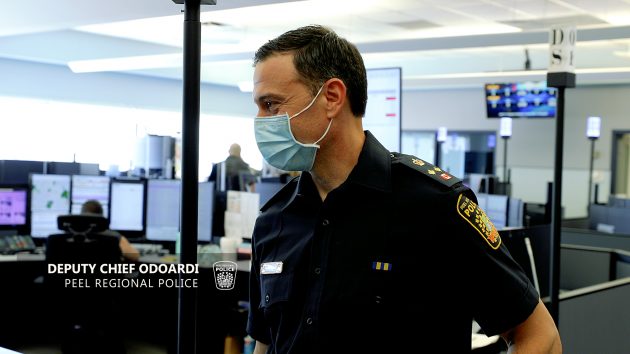
Features
News
Peel Regional Police on the forefront of innovation and technology in policing
June 2, 2021 By Derek Snider
 Peel Police's Real-Time Operations Centre
Credit: Peel Regional Police
Peel Police's Real-Time Operations Centre
Credit: Peel Regional Police It would be almost impossible to ignore the public outcry for changes to policing, if one were unwise enough to try to do that. The simple fact is, most police services and officers are doing things much as they did 30 years ago and that isn’t working for many communities or the front-line officers who serve them.
The Peel Regional Police Service, under the leadership of Chief Nishan Duraiappah, has committed to a course of police reform and modernization, launching a multi-pronged strategy to make its members safer and more effective while providing better and more appropriate services to the 1.4 million residents of Peel Region. It’s a strategy based on having the right people with the right tools and resources at the right time to reduce harm in the community while also building stronger relationships.
Making progress towards a more inclusive, transparent and effective form of community policing requires police services to create new partnerships in the communities they serve. It requires new technologies to make officers more responsive and effective, and to remove some of the bureaucratic burden that consumes so much officer time and energy.
But perhaps most importantly, being a better police service today means developing an internal culture that recognizes and understands the social context in which it operates; a culture that is more open and less defensive in order to build real credibility and trust.
Culture, values and context: closing the say-do gap
Culture is not determined by what you say. It is determined by the behaviours an organization encourages, enables, celebrates and rewards. If members of an organization see a colleague get rewarded for cutting corners to achieve a result, they will adopt that behaviour. If they see leaders avoiding accountability and being vague, defensive or evasive, they will adopt those behaviours.
But, if an organization wants a culture of transparency, accountability and effectiveness, leaders must provide the tools and processes to behave that way. They must model that behaviour and they must celebrate it and reward it when they see it.
The mission of the Peel Regional Police is to equitably and fairly serve all 1.4 million residents of Peel Region. That is what we say, which means that is what we must do to be worthy of trust and respect. Trust is transactional—we build it or lose it with every public interaction. If any PRP employee acts in a way that is at odds with our claim to equitably and fairly serve everyone, it degrades community trust, making our job more difficult and dangerous.
Collaborating to get the right resource for the best result
For generations, police departments have worked for their communities, but apart from their communities—entities unto themselves. Processes, systems, jargon and tight control of information (mandated in many cases by privacy requirements) reinforce a culture of secrecy. At its worst, this creates an us-versus-them divide, which serves neither the police service nor the community.
A more progressive and effective approach for everyone is broad collaboration between police services and a variety of social service providers to ensure community safety and well-being. Police services are part of the solution, but not alone or opaquely. With dramatically overburdened social services, police are often the first or only ones called to deal with all manner of problems they might not be best suited to handle.
By building partnerships with the appropriate social service groups, PRP is able to bring the right resources to a situation that might not really require policing. For example, the PRP deals with many hundreds of mental health crisis calls a year, usually several a day. While PRP officers have some training in this area, they are not mental health professionals. Handling these calls takes officers out of service, often waiting many hours at hospitals to resolve a specific case. But beyond transport to a hospital, they can provide little meaningful aid to a person in crisis.
By partnering with the Canadian Mental Health Association’s Peel Dufferin Branch to create Mobile Crisis Rapid Response Teams (a Registered Nurse, Registered Social Worker or Occupational Therapist teamed with a specially-trained police officer), PRP has been able to divert 70 per cent of mental health crisis 911 calls to appropriate community-based services rather than transporting them to an emergency room. As a result, the individual in crisis is better served, strain is removed from emergency rooms and police resources are more effectively used.
Similarly, PRP collaborated with the Safe Centre of Peel to create a ground-breaking Intimate Partner Violence (IPV) unit to better support survivors of violence and to reduce IPV in Peel. Officers in the IPV Unit received training in anti-racism and culturally appropriate and sensitive responses, domestic violence and sexual assault investigation, victim care and management, and interviewing children to offer better care and support to survivors who have been traumatized. To better meet the needs of Peel’s diverse community, Black, racialized and female officers are available, and members of the unit speak 14 different languages.
The PRP also looks directly to community members for insights through several Chief’s Advisory Committees, including leaders in the Muslim, Black, Asian, Youth and community sectors.
Perhaps the PRP’s most far-reaching collaboration is with the Ontario Human Rights Commission. In this first-of-its-kind collaboration, the PRP has committed to dozens of specific remedies to combat systemic racism and discrimination in policing, to promote transparency and to build trust in the Black, Indigenous and other racialized communities of Peel Region.
“We are committed to engaging the right experts, in data analysis, psychology and policing, and equipping our officers with the right training and the right technology so they can do their jobs equitably and fairly,” said Duraiappah.
The remedies, which were developed by the OHRC, fall into seven categories: acknowledgement, policy guidance, data collection, monitoring and accountability, organizational change and a multi-year plan of action.
Creating a culture of true collaboration makes police smarter, more effective, safer and better able to serve their communities. It also creates an opportunity to build trust and credibility within the community.
Applying the right tools and knowledge to achieve the mission
Frontline officers are the heartbeat of every police service. They need the right information in real-time to maximize their effectiveness, efficiency and safety.
But when the PRP hired an independent auditor to look at its systems and use of technology, the result was disappointing. There was work to do to elevate the service’s ability to meet community needs and give officers the tools they need.
PRP worked with Price Waterhouse Coopers to develop and implement an Innovation and Technology Strategic Roadmap that includes several technology initiatives to enhance service-delivery and community safety and well-being while building trust through transparency and accountability. The over-arching focus is to enable evidence-based decisions and critical thinking in pursuit of continuous improvement of the organization.
Data Analytics raise PRP’s ability to meet community needs
PRP recognized it can’t become a better service without the proper information to inform its decisions. Working with Information Builders Inc., it developed powerful data analysis dashboards that provide accurate real-time information to frontline patrol and other critical areas of the organization.
“Service-wide and local decision-making is now made with emphasis on effort, impact and overall value to our organization,” said Rob Morrone, PRP Director of Strategic Initiative. “This includes focusing on collaboration with external stakeholders to make smart, ethical use of the data we collect and that we will collect moving forward, such as race-based Data.”
Deputy Chief Anthony Odoardi has initiated a PRP Digital Officer Transformation Program focused on enhancing its officers’ ability to increase and improve genuine, human interactions in the community. The program encompasses all technological and innovative initiatives focused on providing frontline officers additional tools to do their job more efficiently and effectively.

PRP purchased 1,200 of the most advanced Body-Worn Camera technologies from Axon Inc
Credit: PRP
This includes:
- Deployed over 2,000 iPhone 12 Pros with seamless integration to existing and future technologies.
- The deployment of Body Worn Cameras (1,200 units) in Canada.
- Early adoption of Digital Evidence Management system, integrated with all PRP’s digital information, community video feeds, officer evidence, MAG disclosure and Ministry of Sol Gen DEMS systems.
- Deployed a Radio-Over-PTT system for Investigative and Support Services.
- Accelerated E-Parade initiative for large-scale video conferencing, virtual corporate announcements and real-time information-sharing capabilities both in-person and remotely;
- The incorporation of live unit dashboards and analytic tools accessible by all areas of the Service for informed and purposeful deployment of resources.
“In order to move the dial on our Digital Officer Transformation Program, for both our members and the community, PRP needed to strategically prioritize and synch our focused activities with innovative technologies that support community safety and well-being,” said Deputy Chief of Innovation and Technology, Anthony Odoardi. “High-tech should ideally equate to high-touch with our community. As we move away from a big, shiny and new technology implementation strategy, we look to purposeful and community-oriented technology to better equip our officers to respectfully serve our community.”
Mobile Tech making officers more capable
PRP members provided real-world information to Price Waterhouse Coopers to enable it to develop a Mobile Technologies and Capabilities Roadmap that is determining the applications that will be delivered to officer smartphones over the next 36 months. That includes: wellness, CSWB and electronic notes apps that feature CPIC, RMS and CAD capabilities, as well as translation and real-time community support services.
First-in-Canada Computer Aided Dispatch system
While Computer-Aided Dispatch isn’t new system, PRP is in the process of replacing its old CAD system with next-generation CAD that integrates with Peel’s Real Time Operations Centre, enabling a seamless transition into the NG-911 space. This highly analytical CAD also provides enhanced data collection capabilities to meet strategic goals and initiatives, including race-based collection opportunities in support of PRP’s legally binding agreement with the Ontario Human Right Commission.
Real-Time Operations Centre
PRP’s new Real-Time Operations Centre (RTOC) is up and running with a goal of full operational ability in October 2021. The RTOC has a Live Unit Dashboard that provides an accurate look at deployable police resources and addresses employee wellness through critical incident tracking.
The RTOC is establishing Memorandum of Understanding agreements to allow the Centre to live-stream CCTV feeds from community partners, recognizing it is crucial to maintain the privacy and confidence of the public while enhancing response and investigative capabilities when incidents are occurring in real-time.
Fastest body-worn camera deployment in Canada
PRP purchased 1,200 of the most advanced Body-Worn Camera (BWC) technologies from Axon Inc. to increaser the efficiency and effectiveness of officers, with vastly improved automation, privacy protection tools, automated transcription, and digital retrieval of community video.
PRP is also testing BWC live-streaming technology to improve service in mental health crisis responses. The technology enables remote, real-time interaction with a mental health professional for frontline officers.
BWCs enable PRP to capture unbiased accounts of police/community interactions, demonstrate the professionalism of PRP officers, improve community safety and well-being, enable transparency, accountability and trust, increase efficiencies in evidence collection and data transfer, and create improved training capabilities.
Throughout the BWC deployment, PRP recognizes concerns some have about the technology and is committed to an informed deployment model that prioritizes community engagement and feedback from external stakeholders and community councils.
Other advancements
PRP is also pursuing many other digital and community initiatives to increase officer safety and effectiveness, and improve service to the community, making it one of the most progressive police services in Canada.
This includes the creation of the Public Safety Broadband Network (PSBN). PSBN is a secure, high-speed, wireless broadband communications network that provides prioritized and exclusive access to wireless data for first responders and commercial critical infrastructure entities, essential in a modern digital society.
“By building the PSBN with its VCOM partners, PRP is owning the responsibility to deliver mission critical services without interruption, even when commercial carrier data service disruption occurs”, Deputy Odoardi said.
Chief Duraiappah said they aren’t taking a progressive path simply for the “sake of being progressive”.
“Everything we do is to help us better serve our community in ways that respect the changing expectations people have of their police,” he said.

Credit: Peel Regional Police
Print this page